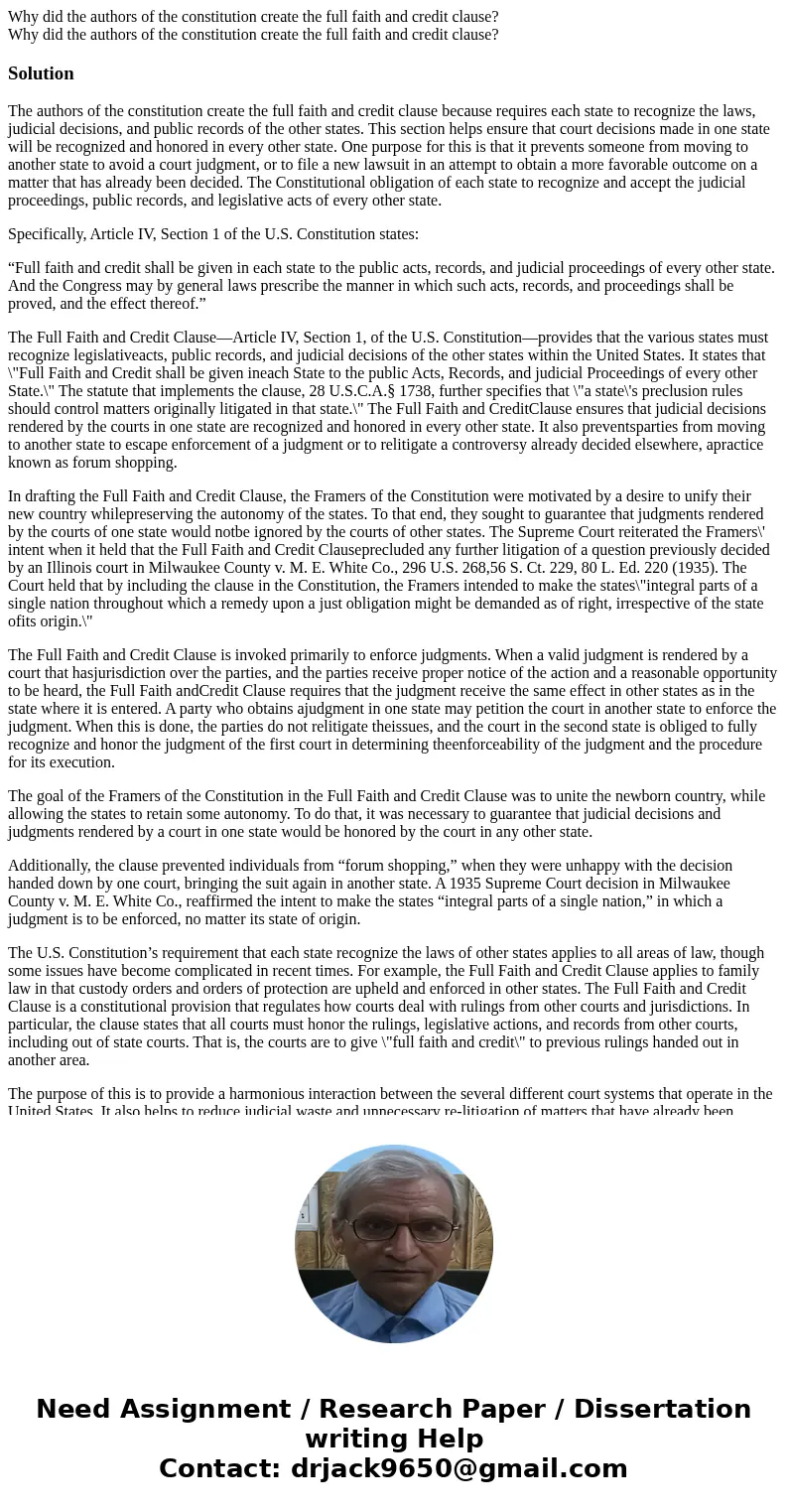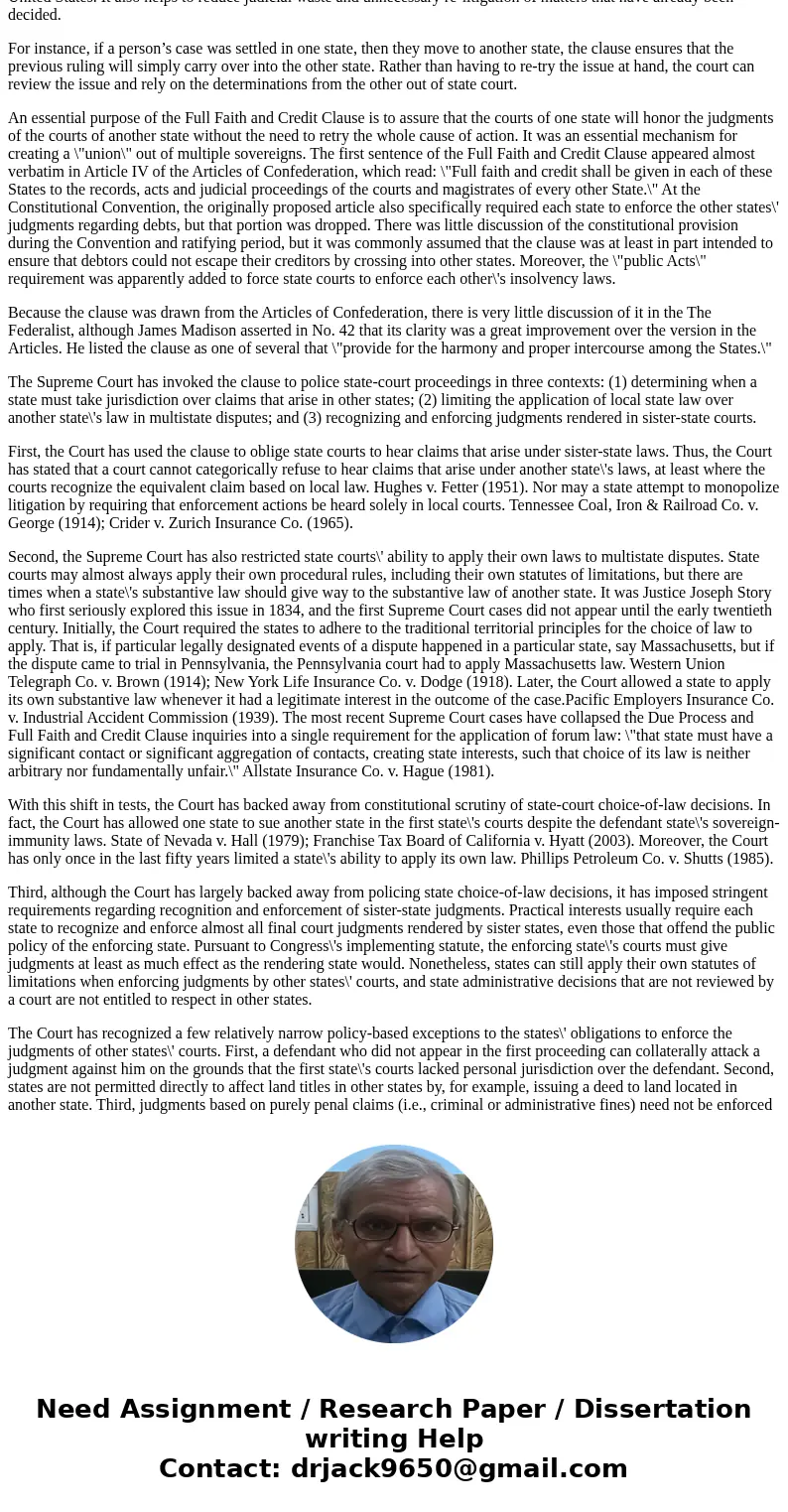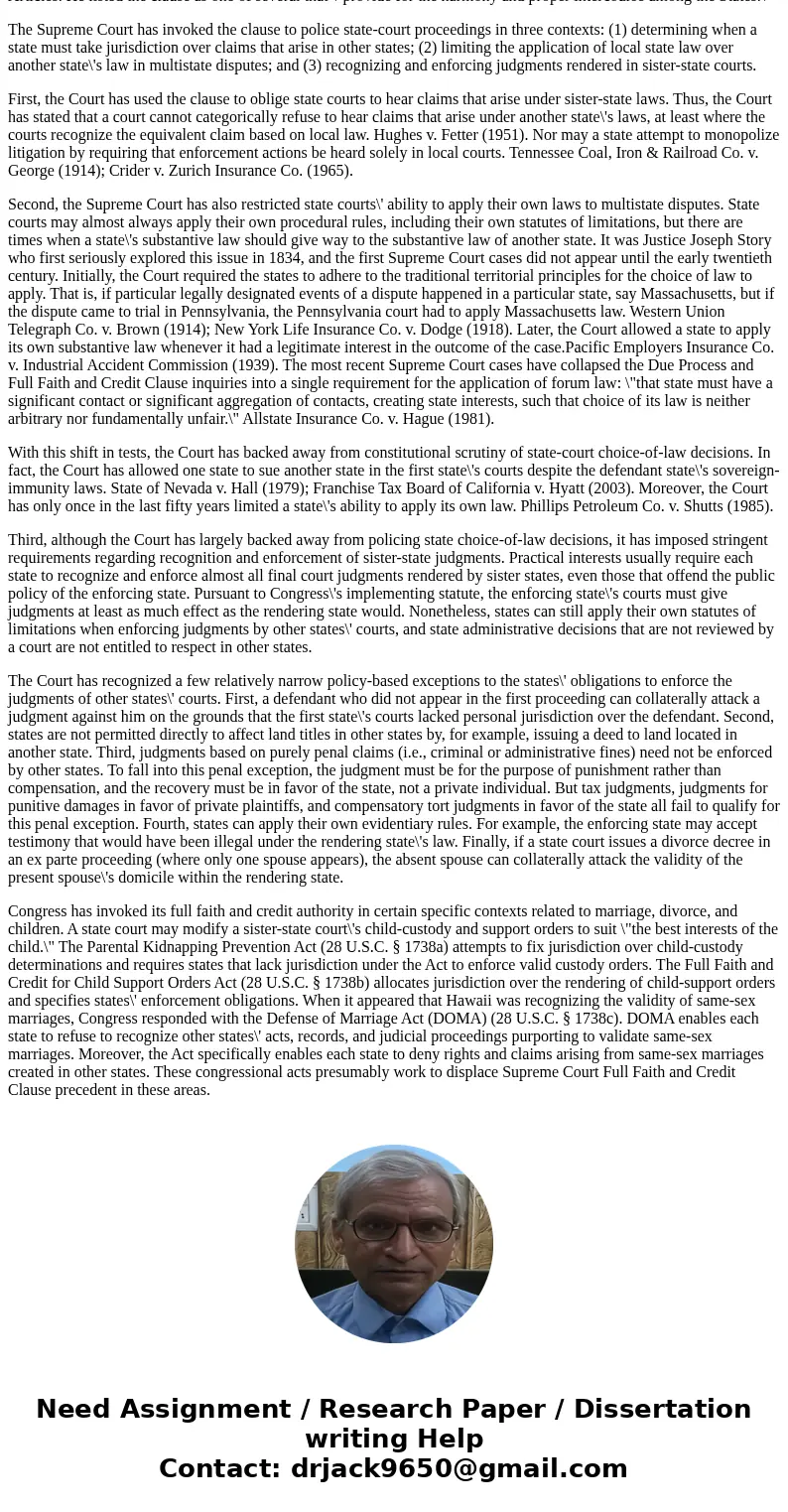Why did the authors of the constitution create the full fait
Solution
The authors of the constitution create the full faith and credit clause because requires each state to recognize the laws, judicial decisions, and public records of the other states. This section helps ensure that court decisions made in one state will be recognized and honored in every other state. One purpose for this is that it prevents someone from moving to another state to avoid a court judgment, or to file a new lawsuit in an attempt to obtain a more favorable outcome on a matter that has already been decided. The Constitutional obligation of each state to recognize and accept the judicial proceedings, public records, and legislative acts of every other state.
Specifically, Article IV, Section 1 of the U.S. Constitution states:
“Full faith and credit shall be given in each state to the public acts, records, and judicial proceedings of every other state. And the Congress may by general laws prescribe the manner in which such acts, records, and proceedings shall be proved, and the effect thereof.”
The Full Faith and Credit Clause—Article IV, Section 1, of the U.S. Constitution—provides that the various states must recognize legislativeacts, public records, and judicial decisions of the other states within the United States. It states that \"Full Faith and Credit shall be given ineach State to the public Acts, Records, and judicial Proceedings of every other State.\" The statute that implements the clause, 28 U.S.C.A.§ 1738, further specifies that \"a state\'s preclusion rules should control matters originally litigated in that state.\" The Full Faith and CreditClause ensures that judicial decisions rendered by the courts in one state are recognized and honored in every other state. It also preventsparties from moving to another state to escape enforcement of a judgment or to relitigate a controversy already decided elsewhere, apractice known as forum shopping.
In drafting the Full Faith and Credit Clause, the Framers of the Constitution were motivated by a desire to unify their new country whilepreserving the autonomy of the states. To that end, they sought to guarantee that judgments rendered by the courts of one state would notbe ignored by the courts of other states. The Supreme Court reiterated the Framers\' intent when it held that the Full Faith and Credit Clauseprecluded any further litigation of a question previously decided by an Illinois court in Milwaukee County v. M. E. White Co., 296 U.S. 268,56 S. Ct. 229, 80 L. Ed. 220 (1935). The Court held that by including the clause in the Constitution, the Framers intended to make the states\"integral parts of a single nation throughout which a remedy upon a just obligation might be demanded as of right, irrespective of the state ofits origin.\"
The Full Faith and Credit Clause is invoked primarily to enforce judgments. When a valid judgment is rendered by a court that hasjurisdiction over the parties, and the parties receive proper notice of the action and a reasonable opportunity to be heard, the Full Faith andCredit Clause requires that the judgment receive the same effect in other states as in the state where it is entered. A party who obtains ajudgment in one state may petition the court in another state to enforce the judgment. When this is done, the parties do not relitigate theissues, and the court in the second state is obliged to fully recognize and honor the judgment of the first court in determining theenforceability of the judgment and the procedure for its execution.
The goal of the Framers of the Constitution in the Full Faith and Credit Clause was to unite the newborn country, while allowing the states to retain some autonomy. To do that, it was necessary to guarantee that judicial decisions and judgments rendered by a court in one state would be honored by the court in any other state.
Additionally, the clause prevented individuals from “forum shopping,” when they were unhappy with the decision handed down by one court, bringing the suit again in another state. A 1935 Supreme Court decision in Milwaukee County v. M. E. White Co., reaffirmed the intent to make the states “integral parts of a single nation,” in which a judgment is to be enforced, no matter its state of origin.
The U.S. Constitution’s requirement that each state recognize the laws of other states applies to all areas of law, though some issues have become complicated in recent times. For example, the Full Faith and Credit Clause applies to family law in that custody orders and orders of protection are upheld and enforced in other states. The Full Faith and Credit Clause is a constitutional provision that regulates how courts deal with rulings from other courts and jurisdictions. In particular, the clause states that all courts must honor the rulings, legislative actions, and records from other courts, including out of state courts. That is, the courts are to give \"full faith and credit\" to previous rulings handed out in another area.
The purpose of this is to provide a harmonious interaction between the several different court systems that operate in the United States. It also helps to reduce judicial waste and unnecessary re-litigation of matters that have already been decided.
For instance, if a person’s case was settled in one state, then they move to another state, the clause ensures that the previous ruling will simply carry over into the other state. Rather than having to re-try the issue at hand, the court can review the issue and rely on the determinations from the other out of state court.
An essential purpose of the Full Faith and Credit Clause is to assure that the courts of one state will honor the judgments of the courts of another state without the need to retry the whole cause of action. It was an essential mechanism for creating a \"union\" out of multiple sovereigns. The first sentence of the Full Faith and Credit Clause appeared almost verbatim in Article IV of the Articles of Confederation, which read: \"Full faith and credit shall be given in each of these States to the records, acts and judicial proceedings of the courts and magistrates of every other State.\" At the Constitutional Convention, the originally proposed article also specifically required each state to enforce the other states\' judgments regarding debts, but that portion was dropped. There was little discussion of the constitutional provision during the Convention and ratifying period, but it was commonly assumed that the clause was at least in part intended to ensure that debtors could not escape their creditors by crossing into other states. Moreover, the \"public Acts\" requirement was apparently added to force state courts to enforce each other\'s insolvency laws.
Because the clause was drawn from the Articles of Confederation, there is very little discussion of it in the The Federalist, although James Madison asserted in No. 42 that its clarity was a great improvement over the version in the Articles. He listed the clause as one of several that \"provide for the harmony and proper intercourse among the States.\"
The Supreme Court has invoked the clause to police state-court proceedings in three contexts: (1) determining when a state must take jurisdiction over claims that arise in other states; (2) limiting the application of local state law over another state\'s law in multistate disputes; and (3) recognizing and enforcing judgments rendered in sister-state courts.
First, the Court has used the clause to oblige state courts to hear claims that arise under sister-state laws. Thus, the Court has stated that a court cannot categorically refuse to hear claims that arise under another state\'s laws, at least where the courts recognize the equivalent claim based on local law. Hughes v. Fetter (1951). Nor may a state attempt to monopolize litigation by requiring that enforcement actions be heard solely in local courts. Tennessee Coal, Iron & Railroad Co. v. George (1914); Crider v. Zurich Insurance Co. (1965).
Second, the Supreme Court has also restricted state courts\' ability to apply their own laws to multistate disputes. State courts may almost always apply their own procedural rules, including their own statutes of limitations, but there are times when a state\'s substantive law should give way to the substantive law of another state. It was Justice Joseph Story who first seriously explored this issue in 1834, and the first Supreme Court cases did not appear until the early twentieth century. Initially, the Court required the states to adhere to the traditional territorial principles for the choice of law to apply. That is, if particular legally designated events of a dispute happened in a particular state, say Massachusetts, but if the dispute came to trial in Pennsylvania, the Pennsylvania court had to apply Massachusetts law. Western Union Telegraph Co. v. Brown (1914); New York Life Insurance Co. v. Dodge (1918). Later, the Court allowed a state to apply its own substantive law whenever it had a legitimate interest in the outcome of the case.Pacific Employers Insurance Co. v. Industrial Accident Commission (1939). The most recent Supreme Court cases have collapsed the Due Process and Full Faith and Credit Clause inquiries into a single requirement for the application of forum law: \"that state must have a significant contact or significant aggregation of contacts, creating state interests, such that choice of its law is neither arbitrary nor fundamentally unfair.\" Allstate Insurance Co. v. Hague (1981).
With this shift in tests, the Court has backed away from constitutional scrutiny of state-court choice-of-law decisions. In fact, the Court has allowed one state to sue another state in the first state\'s courts despite the defendant state\'s sovereign-immunity laws. State of Nevada v. Hall (1979); Franchise Tax Board of California v. Hyatt (2003). Moreover, the Court has only once in the last fifty years limited a state\'s ability to apply its own law. Phillips Petroleum Co. v. Shutts (1985).
Third, although the Court has largely backed away from policing state choice-of-law decisions, it has imposed stringent requirements regarding recognition and enforcement of sister-state judgments. Practical interests usually require each state to recognize and enforce almost all final court judgments rendered by sister states, even those that offend the public policy of the enforcing state. Pursuant to Congress\'s implementing statute, the enforcing state\'s courts must give judgments at least as much effect as the rendering state would. Nonetheless, states can still apply their own statutes of limitations when enforcing judgments by other states\' courts, and state administrative decisions that are not reviewed by a court are not entitled to respect in other states.
The Court has recognized a few relatively narrow policy-based exceptions to the states\' obligations to enforce the judgments of other states\' courts. First, a defendant who did not appear in the first proceeding can collaterally attack a judgment against him on the grounds that the first state\'s courts lacked personal jurisdiction over the defendant. Second, states are not permitted directly to affect land titles in other states by, for example, issuing a deed to land located in another state. Third, judgments based on purely penal claims (i.e., criminal or administrative fines) need not be enforced by other states. To fall into this penal exception, the judgment must be for the purpose of punishment rather than compensation, and the recovery must be in favor of the state, not a private individual. But tax judgments, judgments for punitive damages in favor of private plaintiffs, and compensatory tort judgments in favor of the state all fail to qualify for this penal exception. Fourth, states can apply their own evidentiary rules. For example, the enforcing state may accept testimony that would have been illegal under the rendering state\'s law. Finally, if a state court issues a divorce decree in an ex parte proceeding (where only one spouse appears), the absent spouse can collaterally attack the validity of the present spouse\'s domicile within the rendering state.
Congress has invoked its full faith and credit authority in certain specific contexts related to marriage, divorce, and children. A state court may modify a sister-state court\'s child-custody and support orders to suit \"the best interests of the child.\" The Parental Kidnapping Prevention Act (28 U.S.C. § 1738a) attempts to fix jurisdiction over child-custody determinations and requires states that lack jurisdiction under the Act to enforce valid custody orders. The Full Faith and Credit for Child Support Orders Act (28 U.S.C. § 1738b) allocates jurisdiction over the rendering of child-support orders and specifies states\' enforcement obligations. When it appeared that Hawaii was recognizing the validity of same-sex marriages, Congress responded with the Defense of Marriage Act (DOMA) (28 U.S.C. § 1738c). DOMA enables each state to refuse to recognize other states\' acts, records, and judicial proceedings purporting to validate same-sex marriages. Moreover, the Act specifically enables each state to deny rights and claims arising from same-sex marriages created in other states. These congressional acts presumably work to displace Supreme Court Full Faith and Credit Clause precedent in these areas.



 Homework Sourse
Homework Sourse